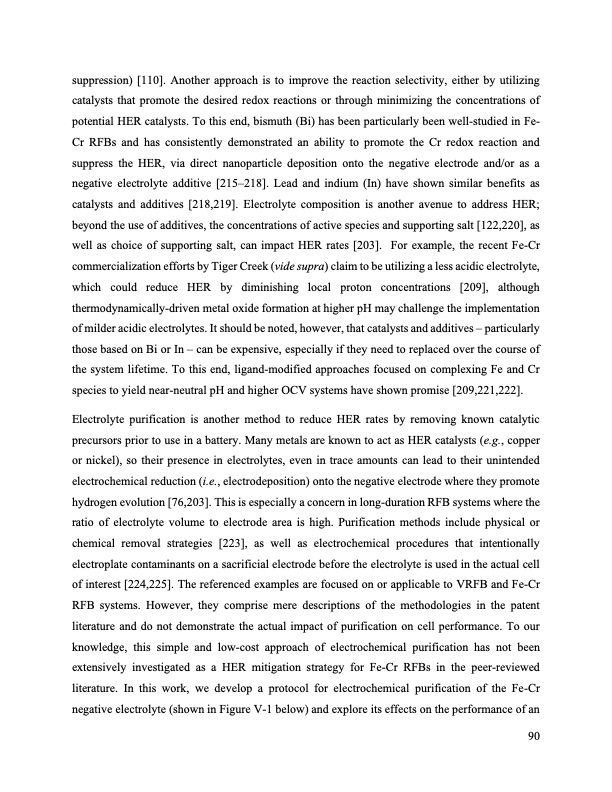
PDF Publication Title:
Text from PDF Page: 090
suppression) [110]. Another approach is to improve the reaction selectivity, either by utilizing catalysts that promote the desired redox reactions or through minimizing the concentrations of potential HER catalysts. To this end, bismuth (Bi) has been particularly been well-studied in Fe- Cr RFBs and has consistently demonstrated an ability to promote the Cr redox reaction and suppress the HER, via direct nanoparticle deposition onto the negative electrode and/or as a negative electrolyte additive [215–218]. Lead and indium (In) have shown similar benefits as catalysts and additives [218,219]. Electrolyte composition is another avenue to address HER; beyond the use of additives, the concentrations of active species and supporting salt [122,220], as well as choice of supporting salt, can impact HER rates [203]. For example, the recent Fe-Cr commercialization efforts by Tiger Creek (vide supra) claim to be utilizing a less acidic electrolyte, which could reduce HER by diminishing local proton concentrations [209], although thermodynamically-driven metal oxide formation at higher pH may challenge the implementation of milder acidic electrolytes. It should be noted, however, that catalysts and additives – particularly those based on Bi or In – can be expensive, especially if they need to replaced over the course of the system lifetime. To this end, ligand-modified approaches focused on complexing Fe and Cr species to yield near-neutral pH and higher OCV systems have shown promise [209,221,222]. Electrolyte purification is another method to reduce HER rates by removing known catalytic precursors prior to use in a battery. Many metals are known to act as HER catalysts (e.g., copper or nickel), so their presence in electrolytes, even in trace amounts can lead to their unintended electrochemical reduction (i.e., electrodeposition) onto the negative electrode where they promote hydrogen evolution [76,203]. This is especially a concern in long-duration RFB systems where the ratio of electrolyte volume to electrode area is high. Purification methods include physical or chemical removal strategies [223], as well as electrochemical procedures that intentionally electroplate contaminants on a sacrificial electrode before the electrolyte is used in the actual cell of interest [224,225]. The referenced examples are focused on or applicable to VRFB and Fe-Cr RFB systems. However, they comprise mere descriptions of the methodologies in the patent literature and do not demonstrate the actual impact of purification on cell performance. To our knowledge, this simple and low-cost approach of electrochemical purification has not been extensively investigated as a HER mitigation strategy for Fe-Cr RFBs in the peer-reviewed literature. In this work, we develop a protocol for electrochemical purification of the Fe-Cr negative electrolyte (shown in Figure V-1 below) and explore its effects on the performance of an 90PDF Image | Bringing Redox Flow Batteries to the Grid

PDF Search Title:
Bringing Redox Flow Batteries to the GridOriginal File Name Searched:
Rodby-krodby-phd-chemE-2022-thesis.pdfDIY PDF Search: Google It | Yahoo | Bing
Salgenx Redox Flow Battery Technology: Salt water flow battery technology with low cost and great energy density that can be used for power storage and thermal storage. Let us de-risk your production using our license. Our aqueous flow battery is less cost than Tesla Megapack and available faster. Redox flow battery. No membrane needed like with Vanadium, or Bromine. Salgenx flow battery
| CONTACT TEL: 608-238-6001 Email: greg@salgenx.com | RSS | AMP |